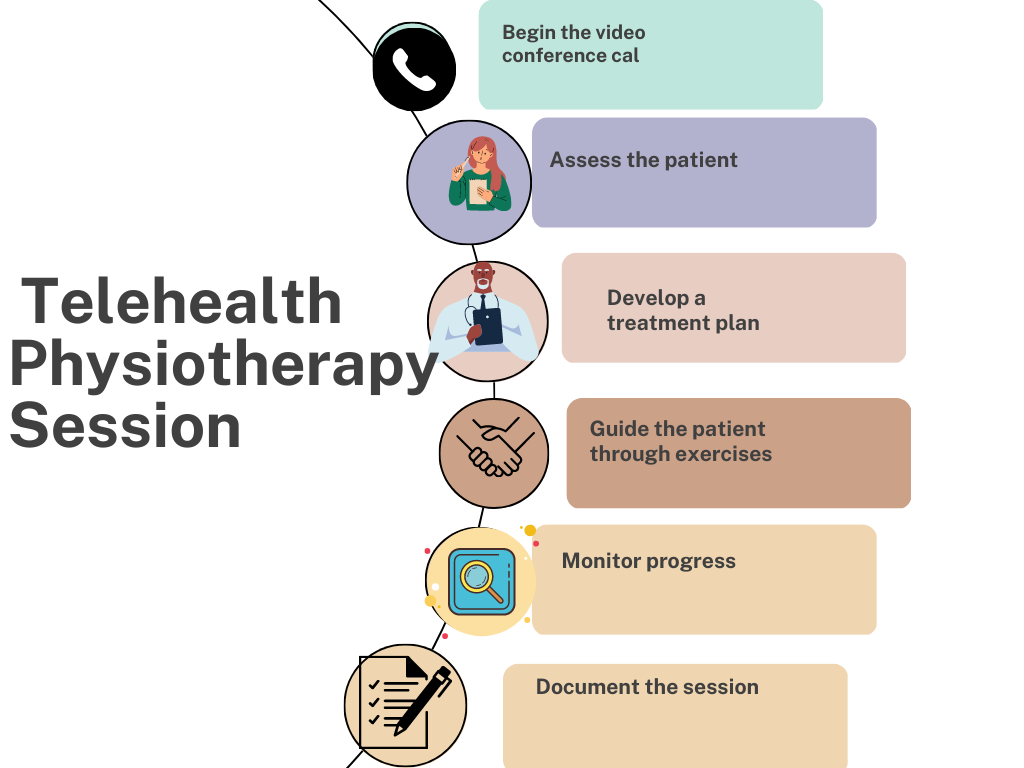90Views 0Comments

Using technology to deliver care to patients remotely, telehealth physiotherapy is a relatively new and quickly expanding field of physiotherapy practice. Videoconferencing between the physiotherapist and the patient is commonly used in telehealth physiotherapy to enable real-time evaluation, treatment, and patient monitoring of patients at a distance.
The effectiveness of telehealth physiotherapy has been the subject of numerous research, and the findings are encouraging. According to one study, telemedicine physical therapy is just as effective as in-person therapy for treating musculoskeletal disorders like shoulder impingement and low back pain. Another study discovered that telemedicine physiotherapy was successful in treating patients with chronic knee pain by reducing pain, enhancing function, and raising patient satisfaction.
Telehealth physiotherapy also offers several benefits over traditional in-person physiotherapy. Patients, for instance, particularly those who live in distant places or have mobility challenges, may find it more convenient. Patients no longer need to travel to a physiotherapy clinic, which can save them time and money. This is another benefit of telehealth physiotherapy. Telehealth physiotherapy may also be more economical for both patients and healthcare systems.
Telehealth physiotherapy does, however, have significant drawbacks. For instance, it might not be appropriate for all patients, especially those with complex illnesses that need manual evaluation and care. Patients undergoing telehealth physiotherapy must also have access to dependable technology and a consistent internet connection, which may not be available to everyone.
Overall, telehealth physiotherapy has showed potential in offering patients efficient and practical distant care. Telehealth physiotherapy is likely to play a bigger role in the practice of physiotherapy as technology continues to advance.
Benefits of telehealth physiotherapy

Telehealth physiotherapy offers several benefits for patients, physiotherapists, and the healthcare system as a whole:
- Convenience: Telehealth physiotherapy provides patients with the convenience of receiving care from the comfort of their own homes. Patients no longer need to travel to a clinic, which can be time-consuming and expensive.
- Access: Telehealth physiotherapy increases access to care for patients who live in rural or remote areas where physiotherapy services may not be readily available.
- Cost-effective: Telehealth physiotherapy can be more cost-effective for patients and healthcare systems. It eliminates the need for patients to travel to clinics, which can be expensive, and reduces healthcare system costs by reducing the need for clinic space and equipment.
- Increased compliance: Patients who receive telehealth physiotherapy may be more likely to comply with their treatment plans because of the convenience and accessibility of the care.
- Real-time feedback: Telehealth physiotherapy allows for real-time feedback and monitoring, which can help physiotherapists adjust treatment plans and provide immediate feedback to patients.
- Better outcomes: Studies have shown that telehealth physiotherapy can be just as effective as in-person physiotherapy in improving patient outcomes, particularly for musculoskeletal conditions.
- Improved patient engagement: Telehealth physiotherapy may increase patient engagement in their care, as patients are more involved in the treatment process and have more control over their care.
Overall, telehealth physiotherapy provides a more convenient, accessible, and cost-effective way for patients to receive physiotherapy care, while still achieving effective treatment outcomes.
Treatments which can be offered with the help oh telehealth physiotherapy

Telehealth physiotherapy can offer a wide range of treatments, depending on the patient’s condition, symptoms, and needs. Here are some examples of treatments that can be offered by telehealth physiotherapy:
Assessment: Telehealth physiotherapy can be used to conduct initial assessments of patients to determine their condition and needs. This may include taking a medical history, assessing range of motion, strength, and mobility, and identifying any areas of pain or discomfort.
Education and self-management: Telehealth physiotherapy can be used to provide patients with education about their condition and how to manage their symptoms. This may include providing advice on exercise, posture, and lifestyle modifications to promote healing and reduce pain.
Exercise therapy: Telehealth physiotherapy can be used to develop and monitor exercise programs tailored to the patient’s condition and needs. The physiotherapist can guide the patient through exercises and provide feedback on technique and form.
Manual therapy: Although hands-on techniques are not possible with telehealth physiotherapy, some manual therapy techniques can be adapted to the online setting. For example, the physiotherapist can guide the patient through self-massage or foam rolling techniques to release muscle tension.
Pain management: Telehealth physiotherapy can be used to provide patients with pain management strategies, such as breathing exercises, relaxation techniques, and mindfulness-based interventions.
Home modifications: Telehealth physiotherapy can be used to provide patients with advice on home modifications to make their living space more comfortable and accessible, such as recommending assistive devices or making changes to furniture placement.
Post-surgical rehabilitation: Telehealth physiotherapy can be used to guide patients through post-surgical rehabilitation programs, including exercise therapy, pain management, and wound care.
Overall, telehealth physiotherapy can provide a range of treatments to patients with a variety of conditions, from musculoskeletal injuries to chronic pain management, and post-surgical rehabilitation. The physiotherapist will work with the patient to develop a personalized treatment plan that addresses their specific needs and goals.

Ways to execute telehealth physiotherapy

To execute telehealth physiotherapy, you will need the following:
- A reliable and secure video conferencing platform: There are several video conferencing platforms available, such as Zoom, Google Meet, or Skype. It is essential to choose a platform that is reliable, easy to use, and ensures patient privacy and confidentiality.
- Access to patient records: Before the telehealth session, the physiotherapist should have access to the patient’s medical history, diagnosis, and any relevant imaging reports to inform the treatment plan.
- Equipment: The physiotherapist will need a computer or tablet with a webcam and a microphone, along with any necessary tools for assessing and monitoring the patient, such as goniometers or resistance bands.
- Communication with the patient: The physiotherapist should provide clear instructions to the patient on how to access the video conferencing platform and any equipment or tools required for the session.
- Informed consent: The patient should be provided with information about the telehealth physiotherapy process and provide informed consent before starting the treatment.
Once the above requirements are in place, the telehealth physiotherapy session can be executed as follows:

- Begin the video conference call: The physiotherapist should start the video conference call at the scheduled time and ensure that the audio and video quality are adequate.
- Assess the patient: The physiotherapist should assess the patient’s condition by asking questions, reviewing medical records, and observing the patient’s movements and posture.
- Develop a treatment plan: Based on the assessment, the physiotherapist should develop a personalized treatment plan that may include exercises, education, and self-management strategies.
- Guide the patient through exercises: The physiotherapist should guide the patient through exercises, providing clear instructions and feedback on form and technique.
- Monitor progress: The physiotherapist should monitor the patient’s progress throughout the session and make any necessary adjustments to the treatment plan.
- Document the session: The physiotherapist should document the session notes and any changes to the treatment plan for future reference.
Overall, executing telehealth physiotherapy requires proper preparation, communication, and equipment to ensure that the patient receives high-quality care remotely.
Softwares which can be useful in telehealth physiotherapy
There are several softwares available which can be useful in telehealth physiotherapy. A few examples are:
- Telehealth platform software: There are several telehealth platform software options available, such as Doxy.me, Physitrack, and SimplePractice. These software applications provide a secure platform for video conferencing and include features such as virtual whiteboards, file sharing, and appointment scheduling.
- Exercise prescription software: Exercise prescription software, such as Physiotools and MedBridge, provide a library of exercises and educational materials that the physiotherapist can use to create personalized exercise programs for the patient. These software applications can also track patient progress and generate reports.
- Wearable technology: Wearable technology, such as Fitbit or Garmin, can be used to monitor patient activity levels and track progress. The data collected from these devices can be shared with the physiotherapist to inform treatment plans.
- Electronic health record (EHR) software: EHR software, such as WebPT and Cliniko, provide a centralized location for patient records, including medical history, diagnosis, and treatment plans. The software can also be used to document telehealth sessions and share information with other healthcare providers.
- Virtual reality software: Virtual reality software, such as XRHealth, provides immersive experiences that can be used in conjunction with traditional physiotherapy techniques to promote healing and reduce pain.
These software applications can help physiotherapists provide high-quality care in a remote setting and enhance the patient experience by providing personalized care and tracking progress. It is important to choose software that is user-friendly, secure, and compliant with relevant regulations to ensure patient privacy and confidentiality.
Takeaway
The practice of providing physiotherapy services to patients virtually through the use of video conferencing and other technology is known as telehealth physiotherapy.
Many advantages of telehealth physiotherapy include greater patient convenience, expanded access to care, and lower healthcare expenditures.
Physiotherapy services delivered via telehealth include exams, exercise recommendations, education, and self-management techniques.
Access to patient records, equipment, communication with the patient, and informed consent are all necessary for the execution of telehealth physiotherapy.
Telehealth physiotherapy can benefit from software such as telehealth platform software, exercise prescription software, wearable technology, electronic health record (EHR) software, and virtual reality software.
To guarantee that the patient receives high-quality care while being treated remotely, telehealth physiotherapy necessitates good planning, communication, and equipment.
Overall, telehealth physiotherapy is a successful method of delivering physiotherapy services remotely, and using technology can improve patient experiences and the effectiveness of treatments.


